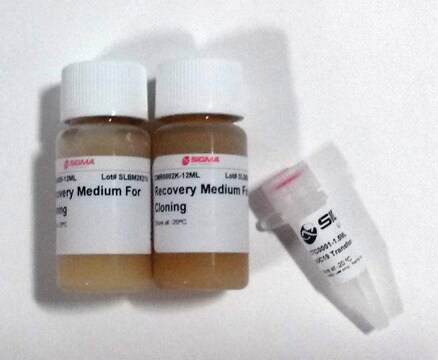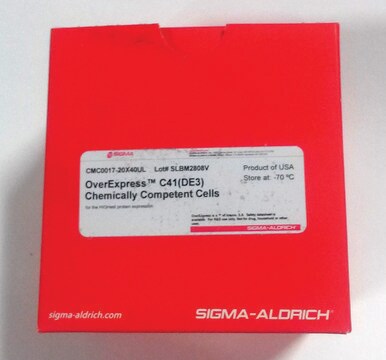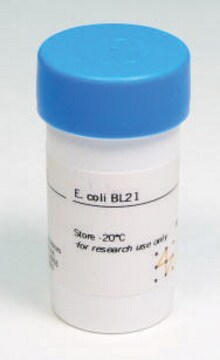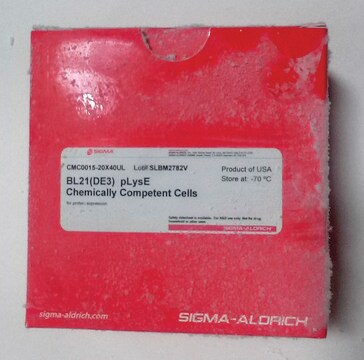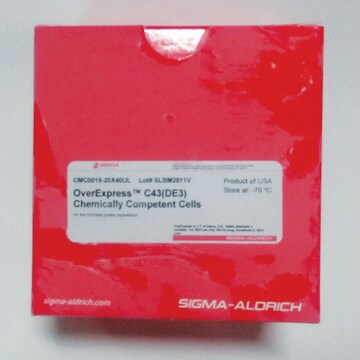CMC0016
BL21(DE3) Electrocompetent Cells
Escherichia coli, rod shaped
Sinônimo(s):
BL21 strain
Faça loginpara ver os preços organizacionais e de contrato
About This Item
Código UNSPSC:
41106202
NACRES:
NA.85
Produtos recomendados
Nome do produto
BL21(DE3) Electrocompetent Cells, for protein expression
fonte biológica
Escherichia coli
grau
Molecular Biology
for molecular biology
modo de crescimento
adherent or suspension
morfologia
rod shaped
técnica(s)
microbiological culture: suitable
transformação celular
competent cell type: electrocompetent
transformation efficiency: ≥5 × 109 cfu/μg
Condições de expedição
dry ice
temperatura de armazenamento
−70°C
Descrição geral
The BL21(DE3) Electrocompetent Cells are the first to offer high efficiency cloning and high level protein expression in the same cell.
Cloning efficiencies are increased 25-1,000 fold relative to other preparations of BL21 cells, which is essential for construction of complex expression libraries.
Genotype
F – ompT hsdSB (rB- mB-) gal dcm (DE3)
Cloning efficiencies are increased 25-1,000 fold relative to other preparations of BL21 cells, which is essential for construction of complex expression libraries.
Genotype
F – ompT hsdSB (rB- mB-) gal dcm (DE3)
Características e benefícios
The unprecedented transformation efficiency of the BL21(DE3) Electrocompetent Cells (> 5 × 109 cfu/μg) eliminates the need for plasmid transfer from the cloning strain to the expression strain, saving days of work in a typical cloning and expression experiment
Componentes
- BL21(DE3) electrocompetent cells
- pUC 19 transformation control DNA
- recovery medium for expression
produto relacionado
Nº do produto
Descrição
Preços
Código de classe de armazenamento
10 - Combustible liquids
Escolha uma das versões mais recentes:
Já possui este produto?
Encontre a documentação dos produtos que você adquiriu recentemente na biblioteca de documentos.
Julianne M Troiano et al.
eLife, 10 (2021-01-16)
Under high light, oxygenic photosynthetic organisms avoid photodamage by thermally dissipating absorbed energy, which is called nonphotochemical quenching. In green algae, a chlorophyll and carotenoid-binding protein, light-harvesting complex stress-related (LHCSR3), detects excess energy via a pH drop and serves as
Felix Nicolaus et al.
eLife, 10 (2021-02-09)
We follow the cotranslational biosynthesis of three multispanning Escherichia coli inner membrane proteins in vivo using high-resolution force profile analysis. The force profiles show that the nascent chain is subjected to rapidly varying pulling forces during translation and reveal unexpected
Salvatore Di Girolamo et al.
Microbial cell factories, 19(1), 170-170 (2020-08-29)
Miniaturization of biochemical reaction volumes within artificial microcompartments has been the key driver for directed evolution of several catalysts in the past two decades. Typically, single cells are co-compartmentalized within water-in-oil emulsion droplets with a fluorogenic substrate whose conversion allows
Protocolos
Nossa equipe de cientistas tem experiência em todas as áreas de pesquisa, incluindo Life Sciences, ciência de materiais, síntese química, cromatografia, química analítica e muitas outras.
Entre em contato com a assistência técnica